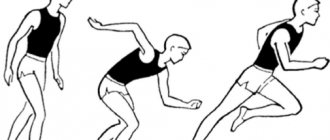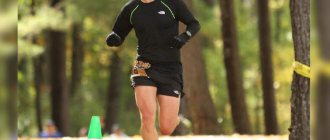As we've already said, not all runners have to love running long distances. For some, less than 10 km is no longer a workout, while others dream of running as fast as Usain Bolt. Of course, it’s better to start small: one or two kilometers will do just fine. After conquering this milestone, you can move on to the next stage. We tell you how to run 3 km quickly and easily. After this, running 5 km will be much easier!
Learning to run fast without training is difficult. The “put on your sneakers and just run” option is unlikely to bring the desired result. Here you need certain tactics, running technique is important, a properly drawn up training plan and, of course, you cannot do without patience and perseverance. Sprinting is different from long-distance running. If during the latter endurance and some psychological aspects are important, then the first implies the ability to correctly calculate your strength and develop the maximum speed possible for you in the shortest possible time.
Further:
What running pace is considered correct?
The running pace will vary depending on the distance and the physical fitness of the runner. However, there are a number of criteria that determine the correct speed for a particular distance:
- Pulse. This is the best indicator that the athlete is running correctly. During an easy jog, your heart rate should not exceed 140 beats per minute. During a tempo cross, the heart rate can increase to 180 beats, but at such values you can continue training only if you are completely confident in your heart health. If there is no such confidence, then it is not recommended to raise your heart rate above 150 beats per minute while running.
- Breath. It should be calm and even. If an athlete begins to feel that there is not enough oxygen and breathing becomes difficult, then running is on the verge of possibilities. This way you can run when the finishing dash is being made, or when the distance does not exceed 3 km and you need to run it at the maximum. In all other cases, failure to breathe is a sign that fatigue will set in very soon, and then the running pace will have to be reduced to a minimum.
- Tightness. Beginners quickly get tired and begin to clench their fists and raise their shoulders. If this is your option, then you are running through willpower alone. The pace must be selected in such a way that there is no need to forcefully control your tightness.
- Squat. When the running pace is high, and the end of the distance is still far away, runners save energy and squat to the ground. This technique, on the contrary, leads to the fact that more energy is spent on leg work. In addition, an increase in step frequency also requires additional energy. If the athlete’s legs are strong, but there is not enough endurance, such a run can still be considered justified; in all other cases, the leg muscles will quickly become clogged with lactic acid.
- Rocking head and body. This is a sure sign of fatigue, and if you continue running at a given pace, you may not have enough strength to complete the distance. However, some athletes, for some reason, choose this particular running technique. Therefore, this criterion should be taken into account only if you are sure that this is not your technique.
Average running speed
This indicator can be used to compare the speed characteristics of long-distance runners. Although it is much more convenient to talk about the time during which the distance is covered.
Men who have the first adult category in running show the following results:
- 10 km – 18.5 km/h.
- 42.2 km – 16.1 km/h.
Masters of sports of international class show results that are 3 km/h higher than the above.
By the way, the average sprint speed of Usain Bolt is 37 km/h at a distance of 100 meters. Let me remind you that the fastest sprint run belongs to him.
The fastest speed over a distance of 42.2 km in 2013 was shown by Wilson Kipsang, who accelerated sharply after 35 km, running at this pace until the finish. Apparently, the athlete found a good way to save energy. His result is 2 hours 3 minutes and 23 seconds, a total of 7403 seconds. Accordingly, his average speed at a distance of 42.2 was 20.5 km/h, which is 1 km/h higher than that of an international-class master of sports.
What is the difference
Running technique, breathing, heart rate, muscle load and other indicators differ depending on the running pace.
Running at a fast pace
Running fast has many benefits. It allows you to achieve high speed, endurance, self-realization, coordination and psychological endurance.
Typically, endurance athletes have a heart rate of 145-165 beats per minute during fast running . At this frequency, the body adapts as the aerobic threshold is exceeded. If the training is designed for speed, the heart rate can increase to 180 beats per minute, but, as already mentioned, only an absolutely healthy athlete can run with such a heart rate.
When running fast, the body needs more oxygen, so inhale deeply, and when exhaling, you need to completely push out the spent air from the lungs.
Reference! It is recommended to use “lower” breathing - first the lower part of the lungs is filled, then the upper. This breathing technique will help avoid tingling in the side.
The main factor in running fast is technique , since only through it can you improve your speed performance. During a marathon, the technique allows you to correctly distribute your forces and increase efficiency; in a sprint, you can achieve a better result.
Fast running technique:
- Arm position - arms should be bent at the elbows, hands relaxed, arm movement should occur in sync with the running rhythm. The arms help the legs and allow one to develop greater speed using less effort.
- Step length is an individual indicator; it depends on the length of the limbs, height and level of physical fitness. Taking too long steps reduces speed because the foot moves ahead of the center of gravity. When you land on your foot, you need to control its position - it should be under the knee. The body remains straight, gaze ahead. It is a mistake to lower the head, as in this case the entire cervical region becomes tense.
Average running pace
By running at a slower pace, the stress on your joints is reduced and the risk of injury is reduced. During an average run, all the muscles of the body are used, including the heart.
Reference! The load at an average pace should be sufficient. If it is too low, the heart muscle will not pump blood fully.
The heart rate during an average running pace is 120-140 beats per minute. Breathing should be such that the runner can carry on a conversation without getting confused. Between inhalation and exhalation you need to take two to four steps.
Running at a slow pace
Doctors say that running at a slow pace is much healthier for your health than running at a fast pace. A slow running pace implies a speed of 7-9 km/hour.
Breathing during easy running is calm and even. Movements are performed without tension, easily . A runner can easily carry on a conversation without getting out of breath.
As for the pulse, its range is 120-150 beats per minute.
Light running trains the muscles, but most of all it is good for the heart.
How to Increase Your Aerobic Capacity
Aerobic endurance is something that is trained by thousands of athletes in a variety of sports. The goal is to push back the aerobic threshold as much as possible, that is, the point after which the formation of lactic acid begins in the muscles.
Here are options for increasing aerobic capacity:
- bicycle rides;
- climbing stairs;
- jumping rope;
- shuttle run;
- cross-country running;
- running uphill;
- interval running;
- skis;
- swimming.
Running pace and speed
Running pace is the opposite of average speed. It is measured in km/min and shows how long it took the runner to run a particular distance. That is, if you control this parameter, you can calculate how long it will take the runner to cover the distance.
Running speed depends on a person’s weight and height, as well as the body’s endurance and the goal.
An average person who trains for health can run a hundred meters in 13-15 seconds. The average running speed for men is 15-20 km/h, for women – 12-15 km/h.
High speed is not necessary for health, it is only necessary for setting records.
What does this parameter affect?
It affects the athlete’s productivity - it shows how long it takes him to run 1 km. Calculating running tempo and speed over distance and time helps to control performance during competitions - the athlete knows exactly whether he needs to speed up, or whether he is within the target limits.
If you play sports professionally, pay attention to calculating your running speed with a pace and discharge calculator - thanks to it, you will be able to calculate in advance how you will need to run in order to meet the standard for the desired discharge. This is a very convenient calculator; it will clearly demonstrate how the values will change if you slightly improve the time or change the tempo numbers
.
A sharp increase in running pace
A break or a sharp increase in running pace is necessary just before the finish line. At this time, the runner must run at maximum speed and to the limit of his capabilities.
Finish acceleration is best trained in short speed intervals that last from 30 seconds to 2 minutes. The training is carried out as follows:
- warm-up;
- 10 sections of 400 meters each.
A slow run will take from 30 seconds to 2-3 minutes, depending on the fitness of the runner. That is, the runner must run 400 meters at maximum speed, then he switches to a slow run, and again makes a dash at maximum speed.
This workout is considered quite difficult to perform. Alternatively, you can run 100, 200, 300 meters and reduce the number of repetitions.
Training program for running three kilometers
Below are sample training programs for different categories of athletes - from beginners to experienced and well-prepared runners. Remember that before training, a good warm-up is necessary, and after running, a cool-down and stretching is a must.
Three kilometers in 15 minutes (for beginners)
At this stage, running training should be carried out at least three times a week, and at each of them cover a distance of three kilometers.
This program takes basic running skills to perfection. At the end of this phase of the training process, the three-kilometer distance should be covered in fifteen minutes.
Here is an approximate plan for weekly training (in total, there should be from six to ten such weeks at this phase of the training process:
- First day: running a distance of five kilometers at speed.
- Day two: running a distance of one kilometer in a minimum of time. We do three approaches, with a one-minute rest between them.
- Third day: running a distance of five kilometers at speed.
Three kilometers in 13 minutes (intermediate level)
At this stage of the training program, classes become of better quality, to develop greater endurance. The distance also increases.
- First day: running a distance of seven kilometers at speed
- Second day: we run one kilometer in a minimum of time. We do three approaches, resting for one minute between them.
- Third day: we run half a kilometer in a minimum of time. We do eight repetitions, between which we walk quickly for a minute as a rest.
Three kilometers in 12 minutes (advanced level)
During this phase of the training process, the number of days for jogging increases to four, the number of kilometers covered remains the same.
Many call this stage the most difficult. Interval training takes place here, that is, alternating intervals of high and low intensity physical activity. For example, running is replaced by squats, then running again.
Here is a sample training plan:
- First day: running at a distance of seven kilometers at speed.
- Second day: runs one kilometer at speed. I do four approaches, with a 40-second rest between each set.
- Third day: we run half a kilometer in a minimum of time. Thus, we do six repetitions with a 40-second rest between them (by rest we mean brisk walking).
- Day four: we run a distance of one kilometer in a minimum of time. We do three repetitions, between which we squat 30 times.
Tips from the professionals
There is a special running pace calculator for professional athletes, but for low-level runners it is useless. Running is not mathematics; you can track your runs using a sports watch.
For those who want to increase the tempo parameter, it is recommended:
- think over a training program, include endurance exercises in them;
- come up with a good motivational factor for yourself;
- do not exercise if you are physically or nervously exhausted;
- purchase sports equipment;
- run in comfortable weather conditions;
- develop leg muscles;
- increase frequency and step length;
- run short distances;
- observe correct running technique;
- Remember that running pace is measured in km, which means you must maintain long distances and improve your time performance at the same time.
You should enjoy running. Set realistic goals for yourself, and then a good mood and positive attitude will help you go from the couch to a 10-kilometer run and even set your own record.











